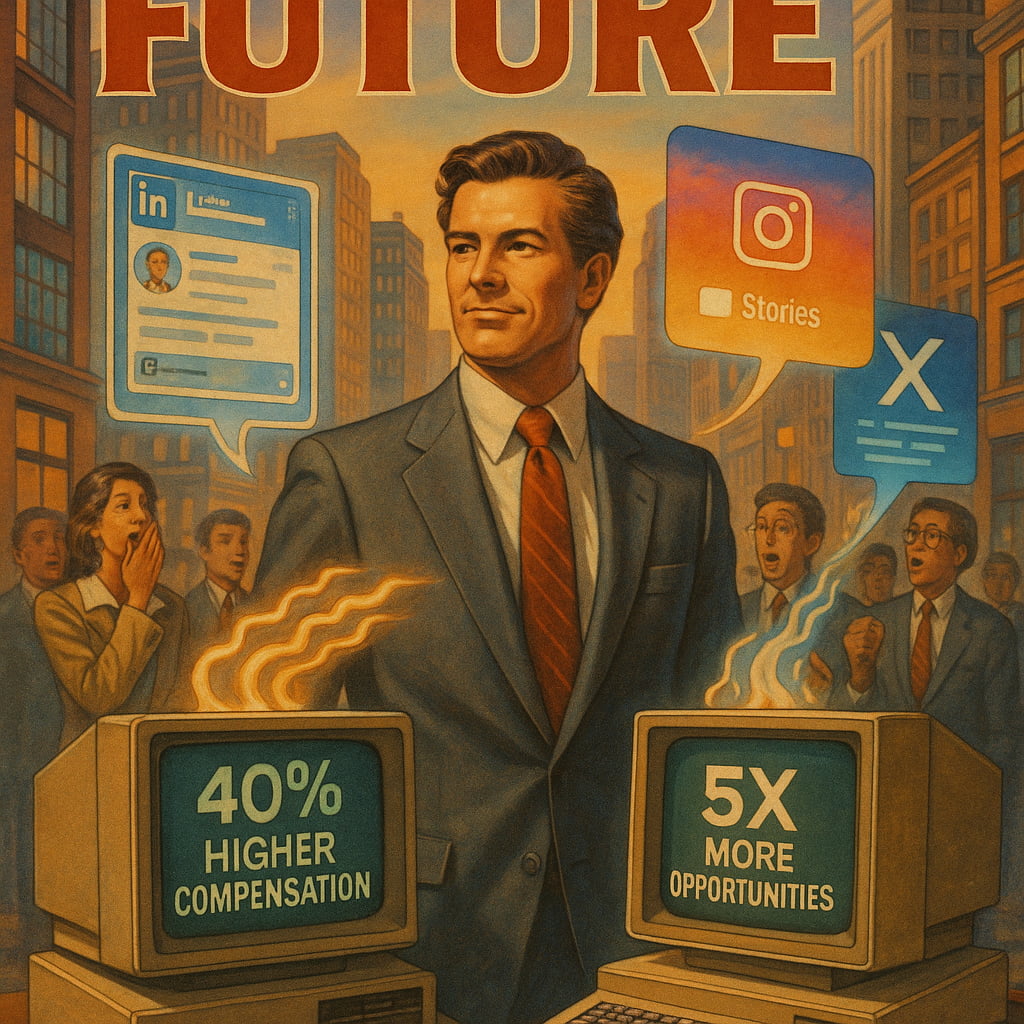AI for Personal Branding



Why AI for Personal Branding Is a Serious Advantage in 2025
Personal branding has evolved from optional career enhancement to strategic necessity. Today's professionals must maintain consistent, high-quality presence across multiple platforms—LinkedIn's professional networking demands differ significantly from Instagram's visual storytelling requirements, while X (formerly Twitter) rewards real-time engagement and thought leadership. Each platform operates with distinct algorithmic preferences and audience expectations.
The transformation is quantifiable: professionals with strong personal brands command 20-40% higher compensation and receive 5x more inbound opportunities than their less visible counterparts. Yet traditional brand-building methods—manual content creation, design work, and market research—require substantial time investments that most professionals cannot sustain.
AI has shifted the paradigm from scarcity to abundance. The question is no longer whether to leverage AI tools, but how to deploy them strategically. Modern language models, trained on vast datasets encompassing millions of successful content examples, democratize capabilities previously reserved for marketing teams and creative agencies. This technological accessibility fundamentally alters the competitive landscape for personal brand development.
What AI Can Actually Help You Do
AI's practical applications in personal branding span three critical areas: content generation, visual design, and strategic analysis.
Content Creation: Modern AI systems generate LinkedIn posts, blog articles, and professional biographies that maintain consistent voice and messaging. These tools analyze successful content patterns across platforms, incorporating trending topics, optimal posting times, and engagement-driving formats. The result is content that performs predictably while reducing production time by 70-80%.
Graphic Design and Templates: AI-powered design platforms eliminate technical barriers to visual content creation. These systems generate professional graphics, social media templates, and brand assets without requiring design expertise. Machine learning algorithms analyze color psychology, typography trends, and platform-specific formatting requirements to produce visually compelling materials.
Data-Driven Strategic Insights: AI analyzes audience behavior patterns, content performance metrics, and competitive positioning to inform brand strategy decisions. These insights reveal optimal posting schedules, content types that drive engagement, and messaging that resonates with target demographics. The analysis capabilities scale beyond human capacity, processing thousands of data points to identify patterns and opportunities.
Machine learning models trained on extensive datasets provide individual creators with enterprise-level capabilities. This technological leverage enables consistent, high-volume content production while maintaining quality standards—a combination previously achievable only through significant resource investment.
Best Practices for Using AI to Build a Personal Brand
Strategic AI implementation requires structured approaches that prioritize quality, consistency, and authenticity over volume.
Define Parameters Before Execution: Establish target audience demographics, brand voice characteristics, and content objectives before engaging AI tools. Successful AI outputs depend on precise input parameters—vague prompts generate generic results that dilute brand identity.
Construct Detailed, Structured Prompts: Effective AI interaction requires specific instructions including tone, format, key messages, and platform requirements. Example: "Write a LinkedIn post for marketing executives about AI adoption challenges, using conversational yet authoritative tone, including one specific statistic, and ending with an engagement question."
Implement Rigorous Editorial Processes: AI-generated content serves as foundation material, not final output. Successful personal brands edit AI content to align with personal experiences, industry insights, and authentic voice characteristics. This human refinement distinguishes professional content from obviously automated material.
Maintain Consistency Across Platforms: Develop brand guidelines that specify voice, visual elements, and messaging themes. Apply these consistently across all AI-generated content to reinforce brand recognition and professional credibility.
Avoid These Common Mistakes: Don't publish unedited AI content, rely solely on AI for strategic decisions, or ignore platform-specific requirements. AI tools supplement human expertise—they don't replace strategic thinking or authentic personal experience.
How To Keep Your Voice When Using AI
Maintaining authentic voice while leveraging AI requires systematic approaches to prompt engineering and content refinement.
Establish Voice Parameters: Document your communication style including preferred vocabulary, sentence structure, and tone variations. Create sample content that exemplifies your authentic voice to serve as reference material for AI prompts and human editing.
Strategic Prompt Engineering: Incorporate personal examples, industry experience, and specific perspectives into AI prompts. Instead of generic requests, provide context about your background, target audience, and unique viewpoints. This approach generates content that reflects your expertise rather than generic industry knowledge.
Implement Brand Style Guardrails: Define non-negotiable elements including terminology preferences, topics to avoid, and communication boundaries. These guardrails ensure AI outputs align with professional standards and personal brand positioning.
Example Comparison:
Poor AI Output: "Artificial intelligence is revolutionizing business operations. Companies should adopt AI tools to remain competitive. AI offers numerous benefits including increased efficiency and cost savings."
Well-Crafted Human-AI Collaboration: "After implementing AI tools across three client projects this quarter, I've observed a 40% reduction in content production time—but only when teams establish clear quality standards upfront. The most successful AI adoption happens when human expertise guides the technology, not the reverse. What's your experience with AI tool implementation?"
The difference lies in personal experience integration, specific metrics, and authentic perspective that reflects genuine professional insight.
The AI Tools Worth Testing (and What They're Best At)
Content Generation Systems: ChatGPT dominates long-form article generation, professional email drafting, social media post creation, and content strategy development. Its strength lies in contextual understanding and conversational output refinement. Jasper specializes in brand voice consistency, marketing copy optimization, multi-platform content adaptation, and SEO-focused content creation. Jasper's training emphasizes commercial content performance over conversational flexibility.
Visual Design Platforms: Midjourney excels at high-quality image generation, concept visualization, brand imagery creation, and professional photography alternatives. Its algorithmic approach produces distinctive visual styles that differentiate brands from generic stock imagery. Canva operates through template-based design automation, social media graphics generation, presentation materials creation, and brand asset management. Canva's strength is accessibility rather than artistic sophistication.
Brand Planning Infrastructure: Notion provides content calendar management, strategy documentation, team collaboration, and performance tracking integration. Its database functionality enables systematic brand development processes. Brandmark focuses on logo design generation, brand identity development, color palette creation, and typography selection. Brandmark's algorithms analyze design trends to produce commercially viable brand assets.
Research and Intelligence Tools: Perplexity delivers real-time information synthesis, industry trend analysis, competitive intelligence, and source verification. Its advantage lies in current information processing and citation accuracy. Glasp specializes in content curation, knowledge management, research organization, and collaborative annotation. Glasp transforms information consumption into systematic knowledge accumulation.
Blaze AI represents the convergence of these specialized capabilities into a unified platform. Rather than managing multiple tools and integrations, Blaze AI combines content generation, visual design, strategic planning, and research functions within a single interface. This integration eliminates workflow fragmentation while maintaining the specialized capabilities that make individual tools valuable.
Final Thoughts
AI amplifies human expertise rather than replacing it. The most effective personal brands emerge from strategic AI implementation guided by clear brand understanding and consistent human refinement. Technology provides scale and efficiency, but authentic professional experience and strategic thinking remain irreplaceable.
Successful AI-powered personal branding requires three fundamental elements: defined brand parameters, systematic content refinement processes, and strategic tool selection. These elements work synergistically to create sustainable, authentic brand presence across multiple platforms while maintaining professional credibility.
The professionals who master AI-human collaboration in personal branding will establish significant competitive advantages. Those who ignore these technological capabilities risk obsolescence in an increasingly digital professional landscape. The choice is clear: strategically integrate AI tools or accept diminished professional visibility and opportunity access.
Why AI-Driven Branding Demands a New Set of Skills
In the digital age, building a personal brand isn’t just about visibility—it’s about strategic differentiation. Professionals today must craft content that resonates across various platforms, adapting tone, format, and messaging based on channel and audience. This demands not only creative writing skills but also the ability to process large amounts of input, market data, and audience feedback in real time. That’s where artificial intelligence becomes an essential partner, not just a tool.
AI systems equipped with natural language processing excel at analyzing vast amounts of social, behavioral, and industry-specific data. This analysis generates valuable insights into tone preferences, keyword positioning, and audience engagement trends—elements critical for executing a successful personal brand strategy. For example, understanding how your content performs on social media platforms like LinkedIn versus Instagram allows you to tailor each post for maximum impact.
Using personal branding AI like Blaze, users can now create and iterate on high-performing assets at speed, but strategy is still crucial. A professional tone may work best for thought leadership on LinkedIn, while more casual storytelling might drive results on X or Instagram. AI can suggest structural patterns and visual formats, but only a clear brand voice ensures consistency.
That’s why success depends on more than automation—it requires ethical decision-making and strategic oversight. The use of AI in branding brings ethical considerations to the forefront: transparency, data integrity, and authenticity are non-negotiable. As AI increasingly influences how we connect and show up on the web, ethics must evolve alongside automation.
Ultimately, AI helps you stay ahead, but only when paired with intent, strategy, and refinement. It empowers professionals to explore bold ideas, showcase differentiated expertise, and build trust in a crowded digital world. Those who invest in these strategies now will craft resilient, future-proof brands others struggle to emulate.


.svg)